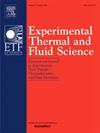Comparison of measured gas flux with Drift Flux Theory in a two-phase counter-current flow channel
IF 3.3
2区 工程技术
Q2 ENGINEERING, MECHANICAL
Experimental Thermal and Fluid Science
Pub Date : 2025-03-25
DOI:10.1016/j.expthermflusci.2025.111479
引用次数: 0
Abstract
This experimental study aims to test the validity of the Drift Flux Theory (DFT) within a lab scale REFLUXTM Flotation Cell (RFCTM). The DFT, which is an analytical model, studies the transport conditions of rising bubbles in downward liquid flux. The model relates the component volumetric fluxes to the relative velocity between the liquid and gas phases and to their volume fractions. This requires measuring the local gas volume fraction and bubble diameter with high spatial and temporal resolution, which remains a challenge due to the limitations of existing sensors. To tackle this problem, newer sensors were used in the current study to revisit the hydrodynamics of the RFCTM. In the current experimental setup, the gas fraction is measured using the Wire-Mesh Sensor, which has a high spatial and temporal resolution of and respectively. The bubble size distribution is measured in situ with an optical process microscope. The experimental parameters, such as gas flux, liquid flux, and wash-water fluxes, were changed to set different conditions in the model. These parameteric values were compared to predictions from the DFT which revealed significant deviations from the theoretical claims made on the basis of simplified transport conditions. The application of the drift-flux theory to highly turbulent multiphase flows, such as RFCTM, must therefore be reviewed and requires further research.

两相逆流通道中实测气体通量与漂移通量理论的比较
本实验研究的目的是在实验室规模的REFLUXTM浮选池(RFCTM)中测试漂移通量理论(DFT)的有效性。DFT是一种分析模型,研究了液体通量向下时气泡上升的输运条件。该模型将组分体积通量与液相和气相之间的相对速度及其体积分数联系起来。这需要以高空间和时间分辨率测量局部气体体积分数和气泡直径,由于现有传感器的局限性,这仍然是一个挑战。为了解决这个问题,在目前的研究中使用了新的传感器来重新审视RFCTM的流体动力学。在目前的实验装置中,气体含量的测量采用了丝网传感器,其空间分辨率和时间分辨率分别为0.5mm和10kHz。用光学过程显微镜原位测量了气泡的大小分布。通过改变实验参数,如气体通量、液体通量和洗涤水通量,在模型中设置不同的条件。将这些参数值与DFT的预测进行比较,DFT显示了与基于简化运输条件的理论主张的显着偏差。因此,漂移通量理论在高湍流多相流(如RFCTM)中的应用必须加以审查,并需要进一步研究。
本文章由计算机程序翻译,如有差异,请以英文原文为准。
求助全文
约1分钟内获得全文
求助全文
来源期刊

Experimental Thermal and Fluid Science
工程技术-工程:机械
CiteScore
6.70
自引率
3.10%
发文量
159
审稿时长
34 days
期刊介绍:
Experimental Thermal and Fluid Science provides a forum for research emphasizing experimental work that enhances fundamental understanding of heat transfer, thermodynamics, and fluid mechanics. In addition to the principal areas of research, the journal covers research results in related fields, including combined heat and mass transfer, flows with phase transition, micro- and nano-scale systems, multiphase flow, combustion, radiative transfer, porous media, cryogenics, turbulence, and novel experimental techniques.
 求助内容:
求助内容: 应助结果提醒方式:
应助结果提醒方式:


